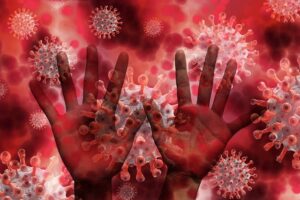Pneumonia is a common respiratory infection that affects millions of people worldwide each year. It can range from mild to severe and, in some cases, can be life-threatening, especially in vulnerable populations. Here, we’ll explore what pneumonia is, its causes, symptoms, how it’s diagnosed and the various treatment options available.
What is Pneumonia?
It is an infection that inflames the air sacs in one or both lungs. These air sacs, known as alveoli may fill with fluid or pus, leading to symptoms such as cough, fever, chills, and difficulty breathing. It can be caused by various infectious agents, including bacteria, viruses and fungi.
Types of Pneumonia
It can be classified based on where it was acquired and the type of infectious agent causing it. The main types include:
1. Community-Acquired Pneumonia (CAP)
This type of pneumonia is acquired outside of hospitals or other healthcare settings. It is the most common form and can result from bacteria, viruses or fungi.
2. Hospital-Acquired Pneumonia (HAP)
HAP occurs in patients during or after a stay in a healthcare facility, such as a hospital. It is often more severe than CAP due to the presence of antibiotic-resistant bacteria.
3. Ventilator-Associated Pneumonia (VAP)
This type of pneumonia develops in people who are on mechanical ventilation in a hospital. VAP is a subtype of HAP and is a significant cause of hospital-related infections.
4. Aspiration Pneumonia
Aspiration pneumonia occurs when food, liquid or vomit is inhaled into the lungs, leading to infection. This type is more common in individuals with swallowing difficulties or impaired consciousness.
Causes of Pneumonia
It can be caused by various microorganisms including:
1. Bacteria 
The most common bacterial cause of pneumonia is Streptococcus pneumoniae. Other bacteria, such as Haemophilus influenzae and Mycoplasma pneumoniae, can also cause the infection.
2. Viruses
Viruses such as influenza, respiratory syncytial virus (RSV) and coronaviruses (including COVID-19) can lead to viral pneumonia. Viral pneumonia is often milder than bacterial pneumonia but can be severe especially in the elderly and those with weakened immune systems.
3. Fungi
Fungal pneumonia is less common and typically affects people with weakened immune systems. Histoplasma, Coccidioides, and Cryptococcus are examples of fungi that can cause pneumonia.
4. Parasites
Though rare, parasites can also cause pneumonia, particularly in people with compromised immune systems or those living in or traveling to areas where these parasites are common.
Symptoms of Pneumonia
Pneumonia symptoms can vary from mild to severe and may include:
- Cough: Often produces phlegm or mucus.
- Fever: Can be high and may be accompanied by chills.
- Shortness of Breath: Difficulty breathing, especially with activity.
- Chest Pain: Sharp or stabbing pain that worsens with deep breaths or coughs.
- Fatigue: General feeling of tiredness or weakness.
- Sweating and Shaking Chills
- Nausea, Vomiting, or Diarrhea
- Confusion: Particularly in older adults.

Diagnosing Pneumonia
It is diagnosed based on a combination of clinical evaluation, medical history and diagnostic tests, which may include:
1. Physical Examination
Doctors listen to the lungs with a stethoscope to detect abnormal sounds such as crackles or wheezing, which can indicate pneumonia.
2. Chest X-Ray
A chest X-ray is commonly used to visualize the lungs and confirm the presence of pneumonia.
3. Blood Tests
Blood tests can help identify the type of infection (bacterial or viral) and check for complications.
4. Sputum Test
A sputum test involves analyzing the mucus produced during coughing to identify the microorganism causing the pneumonia.
5. Pulse Oximetry
This non-invasive test measures the oxygen level in the blood and helps assess how well the lungs are functioning.
Treatment Options for Pneumonia
The treatment for pneumonia depends on the type, severity and underlying cause. Common treatment approaches include:
1. Antibiotics
Antibiotics are the primary treatment for bacterial pneumonia. The specific antibiotic prescribed depends on the type of bacteria and the patient’s health condition.
2. Antiviral Medications
For viral pneumonia, antiviral drugs may be prescribed, particularly in cases of influenza or COVID-19-related pneumonia.
3. Antifungal Treatment
Fungal pneumonia requires antifungal medications, which are often prescribed for an extended period.
4. Supportive Care
Supportive care includes rest, hydration and over-the-counter medications to relieve symptoms such as fever and cough. In severe cases, hospitalization may be required, where oxygen therapy and intravenous fluids are administered.
5. Prevention
Vaccination is a crucial preventive measure against pneumonia. Vaccines such as the pneumococcal vaccine, influenza vaccin and COVID-19 vaccine can help reduce the risk of developing pneumonia.
Complications of Pneumonia
While many people recover from pneumonia without any lasting effects, the infection can lead to complications, especially in high-risk groups. Possible complications include:
- Pleural Effusion: Fluid accumulation around the lungs.
- Lung Abscess: Pus-filled cavity in the lung.
- Bacteremia: Bacterial infection in the bloodstream.
- Acute Respiratory Distress Syndrome (ARDS): Severe lung inflammation that can be life-threatening.
Who is at Risk for Pneumonia?
Certain populations are at higher risk for developing pneumonia, including:
- Infants and Young Children
- Elderly Individuals
- People with Chronic Diseases: Such as asthma, diabetes, or heart disease.
- Smokers
- Individuals with Weakened Immune Systems: Including those with HIV/AIDS, cancer patients, or those on immunosuppressive medications.
Conclusion
It is a serious and potentially life-threatening infection that requires prompt medical attention. Understanding the causes, symptoms and treatment options can help individuals recognize the signs early and seek appropriate care. Preventative measures including vaccination and good hygiene practices are essential in reducing the risk of pneumonia, especially in vulnerable populations.
